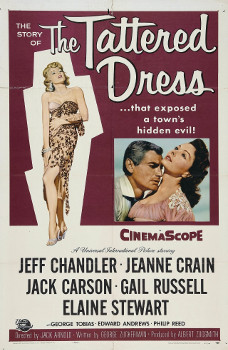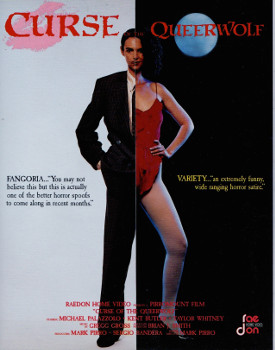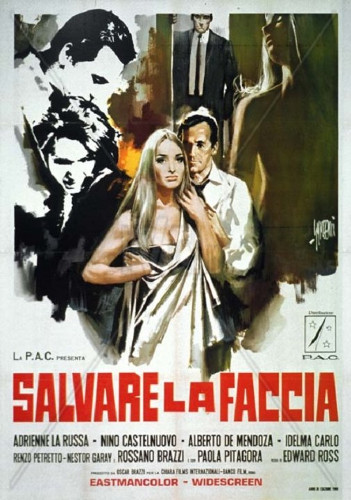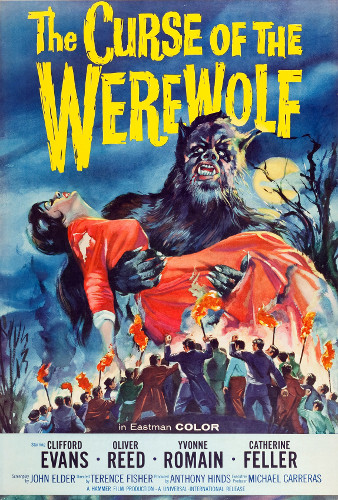Director: Arthur Crabtree
Writer: Herman Cohen and Aben Kandel, from their original story
Stars: Michael Gough, June Cunningham, Graham Curnow and Shirley Anne Field
I was rather shocked to find that I hadn’t seen
Horrors of the Black Museum before. I grew up on this period of British horror movies, watched on my sister’s TV late at night after I was supposed to be asleep, and I’ve seen most of them, including the other couple of pictures in what David Pirie called in his book,
A Heritage of Horror, the ‘Sadian trilogy’ of horror thrillers from Anglo-Amalgamated:
Peeping Tom and
Circus of Horrors. That’s an interesting trio, very different in style and approach but with a common theme of cruel violence, and there’s plenty of that on offer here. Being British films from the tail end of the fifties, they’re polite and courteous in their aberrance and so they occupy a curious midpoint between the amoral excesses of the Grand Guignol and the twisted torture porn of today. In doing this, they were massively influential and it’s fair to say that, without them, we may not have had Vincent Price in eight Edgar Allan Poe adaptations from American International, who coughed up half the budget for this picture.
In fact, Herman Cohen, in his role as producer of the film rather than that of a co-writer of the script, wanted Price in the lead, or at least Orson Welles, but Anglo-Amalgamated successfully lobbied for a British actor, partly because of cost and partly because of the Eady Levy. This was a tax on the box office whose proceeds were divvied up between exhibitors and qualifying British movies; the aim was to support the British film industry by keeping money within it. To qualify for such funding, administered through the newly formed British Film Fund Agency, at least 85% of a picture had to be shot in the United Kingdom or its Commonwealth and there could only be three foreign salaries . Cohen took up one of those slots already, so hiring a British lead avoided an immediate second; Michael Gough was born in Malaysia, but it was British Malaya at the time. He’s a fantastic choice for the role of Edmond Bancroft, the arrogant and quite deranged journalist and author of books on true crime. He would have been one hundred today.
Gough had a long career, debuting on film in 1948 and television as far back as 1946. Originally, as British actors have a tendency to do, he made adaptations of classics. That first TV movie was George Bernard Shaw’s
Androcles and the Lion and that first feature was Tolstoy’s
Anna Karenina, in support of Vivien Leigh and Ralph Richardson. However, most know him from fantastic film, probably for his repeated role as Alfred in no less than four Batman movies, two for Tim Burton and the following two that we pretend don’t exist. When I think of Michael Gough, I think of the villainous Celestial Toymaker in
Doctor Who and the murderous Dr. Armstrong in
The Avengers, two iconic characters in two iconic TV shows, as well as the mad scientist, Dr. Charles Decker, in
Konga. Oddly, his first horror movie saw him play an entirely sane character, Arthur Holmwood in Hammer’s
Dracula in 1958, third billed after Peter Cushing and Christopher Lee, but filmmakers quickly realised that he was even more fun as the bad guy, the villain or the lunatic.
He’s particularly unhinged here as Bancroft, especially as the film runs on. His final scene is gloriously memorable but it’s only one of many because it’s a gift of a character to an actor with classical training who’s willing to ham it up in a horror movie. Bancroft is a writer, the author of many successful books on true crime (his latest is
Terror After Dark) and a journalist who stops in regularly to cock a metaphorical snook at Scotland Yard. It seems that one-upping the peelers is something of a hobby of his and he revels in it. We watch both those aspects of his character often, signing books for fans one moment and politely tormenting Supt. Graham the next. As the film runs on, we also get to see his more twisted side. You see, there’s a killer in town with three victims in two weeks to his name, all women and ‘each murder more horrible than the last.’ Bancroft describes the most recent, conducted with a pair of binoculars with a concealed pair of needles to pierce through the eyes into the brain, as ‘fiendishly clever’.
More importantly, he suggests that the inspiration for such a gruesome device must have come from a similar pair that are stored in the Yard’s own Black Museum. As unlikely as it may seem for a location lauded in the title of a horror movie, this is a real place. Officially named simply the Crime Museum, it was founded in 1874 and contains a vast array of relics of real crimes, including the
From Hell letter, supposedly written by Jack the Ripper, to the fake Millennium Star diamond placed into the Millennium Dome to outwit jewel thieves. It isn’t just famous stuff; it also includes other items of interest, such as shotguns disguised as umbrellas and, oh yes, a pair of binoculars with hidden spikes. These, according to Cohen, were sent by a young stable boy back in the thirties to his master’s daughter. He was in love with her but was fired for having sex with her in a stable and taken aback when she refused to have anything to do with him. When she focused the binoculars, the spikes emerged, skewered her eyes and pierced her brain.
What’s important to note is that the Black Museum, housed today in Room 101 at New Scotland Yard, is not open to the public and never has been since its founding. With the exception of a recent exhibition of selected items at the London Museum, you have to be a policeman, a lawyer or some other professional with a valid reason, to tour the exhibits. It’s funny to watch Supt. Graham and Insp. Lodge rebut Bancroft’s suggestion that a visitor to the museum might be responsible for these new murders and hilarious to watch the police fail to realise that the writer overtly taunting them might be the killer. Actually, he isn’t, not directly, but it can’t be considered a spoiler for me to bring that up. His doctor thinks that he should be hospitalised for ‘unnatural excitement’, a state which he reaches after each murder. ‘It’s my favourite subject,’ he tells Aggie, who runs an antique shop, as he buys a long dagger from her. And it’s only a quarter of an hour in when we visit his own Black Museum, full of weapons and torture devices.
It’s much more than that though. Any horror fan will recognise the characteristics that Gough so gloriously exhibits. He walks with the aid of a cane, leans forward to orate with passion and has hair greying on the sides. In another movie, he’d be distinguished; in this one, he’s clearly involved. It’s less than half an hour in when we see the real killer and immediately piece together most of the plot points we need to figure out everything. This isn’t a movie to surprise us, it’s a movie to shock us with what might honestly be described as the depths of depravity in a British film from 1959 or, to be fair, from anywhere, much nastier in tone than anything that Hammer had shown but keeping their glorious Technicolor. Especially in this sense,
Horrors of the Black Museum predates such pictures as
Jigoku in Japan,
Black Sunday in Italy and
Blood Feast in the United States. Today, of course, it seems tame, not to mention old fashioned, and, frankly, it would have felt that way in the mid-seventies, but Gough keeps an edge on it.
As fantastic as Gough is in this movie, he’s not the only reason to watch. The murders here are more clinically twisted than sexual, unlike
Peeping Tom and
Circus of Horrors, but there is a sexual element that invites us to be voyeuristic. Bancroft is keeping a young lady (and keeping her cooped up); her name is Joan Berkley and she’s played by a curvacious June Cunningham who knows how to use her curves and gets plenty of opportunity to do so. After a heated argument with Bancroft, in which she gets rather vicious in her verbal attacks, she swans off to the pub to dance in front of the locals but leave on her own. She’s such a tease! We’re set up to expect her death, but she’s safely escorted home by a couple of gentlemanly policemen. There she teases us by disrobing for bed and is murdered when she least expects it. I won’t detail how, because there are surprisingly few deaths in this film and I feel that I shouldn’t spoil them. It’s a pivotal moment for this film, though, half an hour in that sets the rest of the plot in motion.
If Gough steals the film and Cunningham gets the opportunity to steal a couple of scenes from him, the rest of the cast are, as was so often the case with British film, thoroughly able support. There are less recognisable faces than usual, though Supt. Graham is a capable Geoffrey Keen, well known as the Minister of Defence, Frederick Gray, in no less than six James Bond films, and to horror mavens as the lead in Hammer’s
Taste the Blood of Dracula. His boss here, Commissioner Wayne, is Austin Trevor, who was the first actor to play Hercule Poirot on screen, in three films back in the early thirties. Also recognisable is Shirley Anne Field, a mainstay in the sixties, with key roles in
The Entertainer,
Saturday Night and Sunday Morning and
Alfie; She was also in
Peeping Tom. However, the most memorable is surely Howard Greene, because he’s the only one to overact. To be fair, he does so deliberately because he plays a madman who confesses to the murders, promising that he’ll use a death ray on the next one. He’s a hoot.
Technically, only the script is really problematic. Arthur Crabtree did everything he could with it as a director and did really well for the most part; he was known more for his comedies for Will Hay and Arthur Askey rather than genre movies, but this, his final film, came right after he directed
Fiend without a Face, a sci-fi horror movie whichwas even more financially succesful than Horrors of the Black Museum; it made back thirteen times its budget rather than the mere seven that this film managed. Desmond Dickinson was responsible for shooting the film and he did a great job without ever attempting to be flash. His camera is content to sit back and watch, often panning or dollying through a room with subtle voyeuristic tendencies, not only in Cunningham’s scenes. There should be a shoutout for the production design crew, because I loved the sets. I want to buy Bancroft’s mansion and fill it with the stuff that Aggie has for sale in her antiques shop. I’d keep Bancroft’s dungeon and study, of course!
For all the great dialogue and outlandish murder, the script is poorly paced and too easily distracted from its sadistic goal; the film is only 78 minutes long and would have been much more memorable had there been an extra twelve of murderous death gadgets. Instead, Jim Nicholson added a gimmick, as was the current trend in genre film. William Castle, the maestro of such gimmicks, had begun a year earlier with
Macabre, handing out a $1,000 life insurance policy with every ticket in case the customer died of fright, but got more and more elaborate. For
House on Haunted Hill, he sent a skeleton over the audience on a wire; he attached vibrating motors to the underside of some seats for
The Tingler; and, for
Mr. Sardonicus, had the audience decide if the title character would live or die. Castle’s pictures weren’t the only ones with gimmicks; screenings of Crabtree’s previous film,
Fiend without a Face, had a ‘living and breathing fiend’ in a display case front of house, twitching its spinal cord and menacing the public with sound effects.
For
Horrors of the Black Museum, Nicholson invented Hypno-Vista, because every cinematic gimmick had to have a hokey name. This involved a twelve minute prologue presented by Emile Franchele, a registered psychologist and hypnotist, who later hosted a TV show in California called
Adventures in Hypnotism and spoke as a hypnotherapist in a 1975 documentary,
Death: The Ultimate Mystery. Franchele explains what hypnotism is, accompanied by basic special effects and the inevitable Archimedes spiral, then proceeds to hypnotise the audience. First, he has us hold their hands together so he can generate enough suggestion to part them against our will, but eventually uses sound and enforcement to persuade us that we’re in London, ready for the film to begin with red double decker buses and recognisable landmarks. Yes, we the audience become part of the movie, ready to be in the room when poor Gail Dunlap triggers the needles in the binoculars she’s been sent and falls lifeless on the carpet.
Well, that’s the idea anyway. Needless to say, it’s completely ludicrous but audiences apparently lapped it up back in 1959, when it was almost expected to have a hokey gimmick to spice up the movie. It’s certainly not the worst thing about this picture. Beyond a troubled script, there are some truly awful make-up effects that supposedly age the murderer but only serve to lessen the impact of what should have been a relatively cool Jekyll & Hyde type subplot; there’s plenty of convenience for the sake of art, such as the thoroughly useful vat of acid that suddenly shows up at the right moment, having never been set up in an early scene; I could also include the bra that Shirley Anne Field wears as Angela Banks, the illicit girlfriend of Bancroft’s assistant, Rick, because it’s notably distracting and could easily have put someone’s eye out. What’s more, for an apparently intelligent crime writer with delusions of grandeur, Bancroft is a complete moron when it comes to covering his tracks.
I won’t say that it’s easy to forgive those flaws, because I’d love to see a version of this without them, but they aren’t as important in a film like this as they would be in something of another genre. This begins with a thoroughly memorable murder, proceeds to enforce that it’s not a one off so setting us up to expect the intricacies of future crimes. In this,
Horrors of the Black Museum sets the stage for
Theater of Blood, the
Dr. Phibes duology and, down the decades, even the
Saw franchise. The flaw that matters most here is the one that takes us away from that, neglecting to set up another such murder every thirty, twenty or even ten minutes. It’s easy to just ditch the Emile Franchele intro sequence and leap straight into the feature, especially as it isn’t included on most versions available on home release, but it’s sadly impossible to replace it with the twelve minutes that should have been included to begin with. It’s an important, pioneering film and birthday boy Michael Gough is glorious, but it pales in comparison to
Theater of Blood.
The Hypno-Vista intro with Emile Franchele can be watched for free on
YouTube.




















































































































































